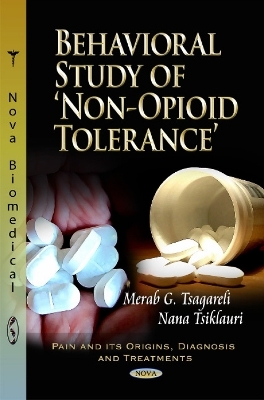
Behavioral Study of 'Non-Opioid' Tolerance
Seiten
2012
Nova Science Publishers Inc (Verlag)
978-1-62100-033-4 (ISBN)
Nova Science Publishers Inc (Verlag)
978-1-62100-033-4 (ISBN)
Pain is a response of the body to the action of injuring stimuli. Notwithstanding an unpleasant experience, it appears to be an important component of the defence system of the organism and a permanent regulator of homeostatic reaction. This book presents and examines research discovered in a behavioural study of 'non-opioid' tolerance.
Pain is a response of the body to the action of injuring stimuli. Notwithstanding an unpleasant experience, it appears to be an important component of the defence system of the organism and a permanent regulator of homeostatic reaction. The organism's reaction to pain is a multi-component one and involves sensory-discriminative, emotional-affective and cognitive characteristics. Clinically, neuropathic pain is characterised by spontaneous ongoing or shooting pain and evoked amplified pain responses after nocuous or innocuous stimuli. The study of pain, therefore, and search for the treatment strategies have a paramount role in modern neurobiology. Numerous anatomy-physiological studies have revealed a number of brain structures involved in the shaping of pain and endogenous analgesia. This book presents and examines current research discovered in a behavioural study of 'non-opioid' tolerance.
Pain is a response of the body to the action of injuring stimuli. Notwithstanding an unpleasant experience, it appears to be an important component of the defence system of the organism and a permanent regulator of homeostatic reaction. The organism's reaction to pain is a multi-component one and involves sensory-discriminative, emotional-affective and cognitive characteristics. Clinically, neuropathic pain is characterised by spontaneous ongoing or shooting pain and evoked amplified pain responses after nocuous or innocuous stimuli. The study of pain, therefore, and search for the treatment strategies have a paramount role in modern neurobiology. Numerous anatomy-physiological studies have revealed a number of brain structures involved in the shaping of pain and endogenous analgesia. This book presents and examines current research discovered in a behavioural study of 'non-opioid' tolerance.
Introduction; Pain & Nociception; Ascending Pain Signal Pathways; Downstream Modulation Of Pain; Tolerance To Opioid Drugs; Periaqueductal Grey Matter; Non-Opioid Analgesics Induced Tolerance; Comparison of the Effects of Tolerance in Juvenile & Adult Rats; The Central Nucleus of Amygdala is Involved in Tolerance to the Antinociceptive Effect of NSAIDs; Tolerance Induced by Non-Opioid Analgesics; Microinjected into Periaqueductal Grey Matter.
| Verlagsort | New York |
|---|---|
| Sprache | englisch |
| Maße | 230 x 155 mm |
| Gewicht | 204 g |
| Themenwelt | Medizin / Pharmazie ► Medizinische Fachgebiete ► Schmerztherapie |
| ISBN-10 | 1-62100-033-8 / 1621000338 |
| ISBN-13 | 978-1-62100-033-4 / 9781621000334 |
| Zustand | Neuware |
| Haben Sie eine Frage zum Produkt? |
Mehr entdecken
aus dem Bereich
aus dem Bereich
Neurophysiologie, Injektionstechnik und Therapievorschläge
Buch | Hardcover (2019)
Thieme (Verlag)
CHF 118,95
Ein Ratgeber für Betroffene und Angehörige
Buch | Softcover (2020)
Springer Berlin (Verlag)
CHF 34,95


